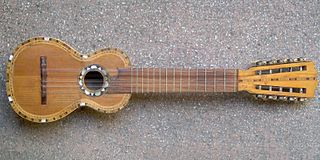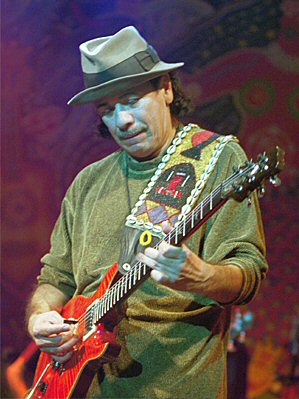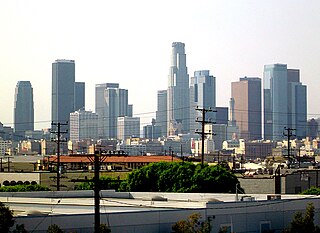This is a list of notable Argentinean musicians and singers:

The charango is a small Andean stringed instrument of the lute family, from the Quechua and Aymara populations in the territory of the Altiplano in post-Colonial times, after European stringed instruments were introduced by the Spanish during colonialization. The instrument is widespread throughout the Andean regions of Bolivia, Peru, Ecuador, northern Chile and northwestern Argentina, where it is a popular musical instrument that exists in many variant forms.

The most distinctive music of Uruguay is to be found in the tango and candombe; both genres have been recognized by UNESCO as an Intangible Cultural Heritage of Humanity. Uruguayan music includes a number of local musical forms such as murga, a form of musical theatre, and milonga, a folk guitar and song form deriving from Spanish and italian traditions and related to similar forms found in many American countries.

The music of Argentina includes a variety of traditional, classical and popular genres. One of the country's most significant cultural contributions is the tango, which originated in Buenos Aires and its surroundings during the end of the 19th century and underwent profound changes throughout the 20th century. Folk music was particularly popular during the 20th century, experiencing a "boom" in popularity during the 1950s and 1960s thanks to artists such as Atahualpa Yupanqui and Mercedes Sosa, prominent figures of the Nuevo cancionero movement. In the mid-to-late 1960s, the countercultural scene of Buenos Aires originated Argentine rock, considered the earliest incarnation of Spanish-language rock for having an autochthonous identity that differed from that of England or the United States. It was widely embraced by the youth and since then has become part of the country's musical identity as much as traditional music. According to the Harvard Dictionary of Music, Argentina also "has one of the richest art music traditions and perhaps the most active contemporary musical life.

The music of Colombia is an expression of Colombian culture, music genres, both traditional and modern, according with the features of each geographic region, although it is not uncommon to find different musical styles in the same region. The diversity in musical expressions found in Colombia can be seen as the result of a mixture of Amerindian, African, and European influences, as well as more modern American.

Mexican rock music, often referred to in Mexico as rock nacional, originated in the 1950s. Standards by The Beatles, Elvis Presley, The Everly Brothers, Nancy Sinatra, and Chuck Berry were soon covered by bands such as Los Apson, Los Teen Tops, Los Twisters, Los Hitters, Los Nómadas, Los Rockets, Los Rebeldes del Rock, Los Locos del Ritmo, Los Crazy Boys, and Javier Bátiz, which later led to original compositions, often in English. The group "Los Nómadas" was the first racially integrated band of the 1950s. Their lead guitarist, Bill Aken, wrote most of their original material, including the raucous Donde-Donde, and co-wrote the material for their Sounds Of The Barrio album, which is still being sold. Their 1954 recording of She's My Babe was the first top 40 R&B recording by a Latino band. In the southwestern United States, Spanish guitar rhythms and Mexican musical influences may have inspired some of the music of American musicians Ritchie Valens, Danny Flores, Sam the Sham, Roy Orbison, and later, Herb Alpert. Initially, the public exhibited only moderate interest in them, because the media attention was focused on La Ola Inglesa.
Chilean rock is rock music and its corresponding subgenres produced in Chile or by Chileans. Chilean rock lyrics are usually sung in Spanish so can be considered as part of rock en español, although sometimes are sung in English as well.
Argentine rock is rock music composed or performed by Argentine bands or artists mostly in Spanish.

Norberto Aníbal Napolitano, popularly known as Pappo, was an Argentine rock musician, guitarist, singer and songwriter. He was and is one of the most influential figures in Argentine music, and in addition to being one of the forerunners of Argentine rock. Besides, he was one of the first to venture into heavy metal in his country and blues of the same.
Uruguayan rock first emerged in Uruguay in the 1950s. The real breakthrough for rock in Uruguay, however, as in much of the world, came with the arrival of The Beatles in the early 1960s. Although the country has a small population and is far-removed from the world's cultural centres, rock music from these land, which has always taken on an identity forged from a mix of different cultures and local peculiarities, crossing different genres and styles, has largely been a well-kept secret outside the region. Thanks to the Internet and easy access to music libraries through streaming services such as Spotify, this is now changing.

The Chacarera is a dance and music that originated in Santiago del Estero, Argentina. It is a genre of folk music that, for many Argentines, serves as a rural counterpart to the cosmopolitan imagery of the Tango. A dance form played by contemporary musicians as soloists or in small ensembles of voice, guitar, violin and bombo drum, the Chacarera is often legitimized by its “origin” in the remote province of Santiago del Estero.

Rock en español is a term used widely in the English-speaking world to refer any kind of rock music featuring Spanish vocals. Unlike English-speaking bands, very few acts reached worldwide success and often not even between different Spanish-speaking countries due to a lack of promotion. Despite rock en español's origins in the late 1950s, many rock acts achieved at best nationwide fame until the Internet consolidated the listeners. However, some rock en español artists did become internationally popular with the help of a promotional campaign from the mid 1980s to the mid 1990s called "Rock en tu idioma". Some specific rock-based styles influenced by folkloric rhythms have also developed in these regions. Some of the more prominent styles are Latin rock ; Latin alternative, an alternative rock scene which blended a Latin sound with other genres like Caribbean ska, reggae, and soca; or Andalusian rock, a flamenco-influenced style that emerged in Spain.
The Uruguayan Invasion was a musical phenomenon of the 1960s similar to the British Invasion, with rock bands from Uruguay gaining popularity in Argentina.
Latin alternative, or "alterlatino", is a brand of Latin rock music produced by combining genres like alternative rock, lofi, chillout, metal, electronica, hip hop, new wave, pop rock, punk rock, reggae, and ska with traditional Ibero-American sounds, in Latin Europeans and Latin Americans countries.

Bajofondo is a Río de la Plata-based music band consisting of eight musicians from Argentina and Uruguay, which aims to create a more contemporary version of tango and other musical styles of the Río de la Plata region. It was founded in the early 2000s as a studio experiment, which culminated into the successful album Bajofondo Tango Club. This led to touring and eventually to the current lineup. Bajofondo calls itself a collaborative as all members have solo careers as well. The group has toured around the world, particularly in Latin America, the United States, Europe and parts of Asia. Their music is known to a wider audience than those who know their name as their music has been used in film and television.

As well as being one of the most important cities in the world in the film industry, Los Angeles, California, is also one of the most important places in the world for the recorded music industry. Many landmarks in Los Angeles – such as Capitol Records, whose headquarters resembles a stack of albums – are representative of this. A&M Records long occupied a studio off Sunset Boulevard built by Charlie Chaplin. The Warner Bros. built a major recording business in addition to their film business.
This is a list of lists of musicians.

Xavier Moyano is an Argentine musician; producer, performer, composer, and educator. He began his career as a session guitarist in Tucuman in 1999. By 2003 was the guitarist for rock/pop band "AVe Cesar" until 2008, after that he became a solo rock instrumentalist. Between 2009 and 2011 he was guitarist and composer of metal band "Seliger" (Argentina/Brasil), between 2014 and 2019 he was guitarist and producer of "Cossas Novas", since 2018 he is guitarist and co-producer of "Rock Bro's" (ClassicRock). He is currently a solo guitarist, session musician and producer.
The Argentine heavy metal is a heavy metal music movement that originated in Argentina in the 1980s. The first popular artist was Pappo, who created the band Riff influenced by the contemporary new wave of British heavy metal. V8 was formed at that time as well, and most of its members created notable bands after their respective departures from the band: Ricardo Iorio and Walter Giardino, currently in Almafuerte and Rata Blanca, are still popular. The second half of the 1980s saw the success of hard rock bands such as Kamikaze, Alakran and Rata Blanca, with an aesthetic similar to the contemporary glam metal. Thrash metal bands, such as Hermética, Horcas and Lethal, appeared in the late 80s and early 90s.